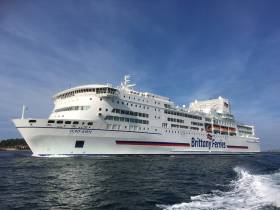Displaying items by tag: Season 2017 figures
Season Concludes With Increased Passengers for Brittany Ferries in 2017
#ferrynews - Cruiseferry Pont-Aven has made its final Ireland-France voyage of the year, marking the end of the Brittany Ferries 2017 sailing season.
Building on the success of 2016 when numbers were up by 3%, 2017 showed a further 4% increase on the number of people travelling on the Cork-Roscoff route. The cruise-ferry operator carried more than 87,000 passengers in the year and ended the season strongly with 4,100 passengers and 1,157 cars on the last two sailings of the season.
While France continues to be a popular travel destination for Irish travellers, equally the number of French people visiting Ireland with Brittany Ferries show no signs of waning as the number of French passengers travelling with the cruise-ferry operator continued to grow. 2017 saw nearly 45,000 French passengers avail of the route, representing 52% of all passengers carried on the Cork-Roscoff crossings.
Commenting on the 2017 season, General Manager Hugh Bruton said, "2017 was another successful season for Brittany Ferries. We have experienced strong passenger growth over the last few years and we are delighted to report that this trend has continued again this year. France has so much to offer holidaymakers, from family fun, to those searching for adventure activities, to golfing getaways. We’re also delighted to see that our French passenger numbers remain strong, as Brittany Ferries continues to make a valuable contribution to the Irish economy. We look forward to building on the success of 2017 and welcoming new and returning passengers in 2018, in what will be the 40th anniversary of our Cork-Roscoff route.”
Earlier this year, Afloat reported on Brittany Ferries £175m order of a new LNG-powered ferry,Honfleur to operate the Portsmouth-Caen route. Due to be delivered in 2019, she will come with an innovative fuel delivery and storage system to help navigate a way around the absence of LNG storage in ports.
Although the 2017 season has concluded, holidaymakers planning their next escape can book now for 2018 and avail of a 15% early booking discount. Passengers will also have the added benefit of being able to secure their preferred travel dates and accommodation.
The Pont-Aven continues to offer the fastest direct ferry crossing from Ireland to France, taking just 14 hours and operating to a convenient weekend schedule. The state-of-the-art ship is the newest and most modern ship to be found on any direct crossing between Ireland and France. Afloat adds that the first outbound sailing from Cork to Roscoff resumes on 31st March.
Passengers can enjoy an authentic French on board experience, unmatched cruise style standards and award-winning service and cuisine. Facilities include pool and bar areas with panoramic sea views, two cinemas, shopping malls, luxurious spa treatments and a wide range of restaurants as well as complimentary Wi-Fi in all public areas of the ship.
























































